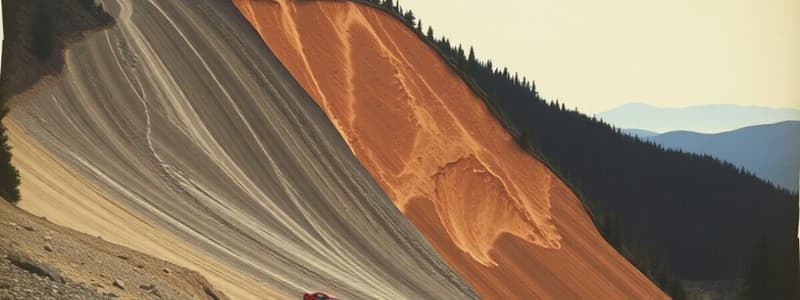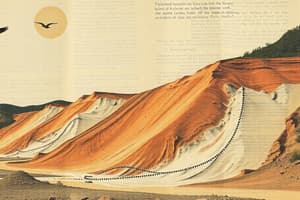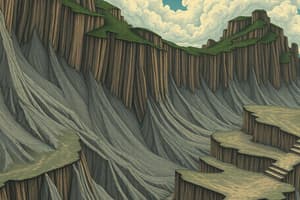Podcast
Questions and Answers
FLUVIAL EROSION is caused by flowing ______.
FLUVIAL EROSION is caused by flowing ______.
water
WEATHERING involves breaking down ROCKS and ______ on Earth’s surface.
WEATHERING involves breaking down ROCKS and ______ on Earth’s surface.
MINERALS
EROSION typically implies that worn-down materials are ______ away.
EROSION typically implies that worn-down materials are ______ away.
transported
A LANDSLIDE can be defined as the failure and downslope movement of rock or ______ materials due to gravity.
A LANDSLIDE can be defined as the failure and downslope movement of rock or ______ materials due to gravity.
Mass wasting refers to the movement of mass down a ______ due to gravity.
Mass wasting refers to the movement of mass down a ______ due to gravity.
A SLUMP occurs above a curved ______.
A SLUMP occurs above a curved ______.
CREEP is characterized by very slow movement of soil and ______ materials.
CREEP is characterized by very slow movement of soil and ______ materials.
Mass of unconsolidated material can move downward and spread ______.
Mass of unconsolidated material can move downward and spread ______.
The presence of excess ______ can often cause a SLUMP to occur.
The presence of excess ______ can often cause a SLUMP to occur.
FLOWS can range from extremely slow to extremely ______.
FLOWS can range from extremely slow to extremely ______.
CREEP results in cracked ______ due to the gradual movement of materials.
CREEP results in cracked ______ due to the gradual movement of materials.
SLIDES can be categorized as SLUMP and various types of ______.
SLIDES can be categorized as SLUMP and various types of ______.
CREEP is prevalent on ______ surfaces.
CREEP is prevalent on ______ surfaces.
FALLS are an EXTREMELY RAPID or VERY RAPID form of ______
FALLS are an EXTREMELY RAPID or VERY RAPID form of ______
ROCKFALLS and SOIL FALLS can also be driven by HYDROSTATIC PRESSURE and the presence of water in ______ cracks.
ROCKFALLS and SOIL FALLS can also be driven by HYDROSTATIC PRESSURE and the presence of water in ______ cracks.
A rock slide buries ______.
A rock slide buries ______.
SLUMP is sliding encountered when a thick layer/slice of ______ material is on a curved slope.
SLUMP is sliding encountered when a thick layer/slice of ______ material is on a curved slope.
ROCK AVALANCHES involve larger rocks moving downhill quickly, fragmenting to form smaller ______.
ROCK AVALANCHES involve larger rocks moving downhill quickly, fragmenting to form smaller ______.
The mass of UNCONSOLIDATED MATERIAL moves DOWNWARD and spreads ______.
The mass of UNCONSOLIDATED MATERIAL moves DOWNWARD and spreads ______.
Erosion by rivers/streams and wave action below is also known as ______.
Erosion by rivers/streams and wave action below is also known as ______.
A curved trunk is known as a ______.
A curved trunk is known as a ______.
Mass wasting is generally associated with ______ materials.
Mass wasting is generally associated with ______ materials.
Creep can be enhanced by frozen subsoil preventing water ______.
Creep can be enhanced by frozen subsoil preventing water ______.
Solifluction is creep triggered by freeze-thaw in ______ climates.
Solifluction is creep triggered by freeze-thaw in ______ climates.
Mudflows and debris flows can have extremely ______ movement of unconsolidated materials.
Mudflows and debris flows can have extremely ______ movement of unconsolidated materials.
Mudflow is the flow of (water) saturated unconsolidated material whose grains are ______-sized or smaller.
Mudflow is the flow of (water) saturated unconsolidated material whose grains are ______-sized or smaller.
Debris flow refers to saturated unconsolidated material with grains that are ______-sized or larger.
Debris flow refers to saturated unconsolidated material with grains that are ______-sized or larger.
Soil particles vary in ______.
Soil particles vary in ______.
CLAY particles are smallest with DIAMETERS less than ______ mm.
CLAY particles are smallest with DIAMETERS less than ______ mm.
SILT particles have DIAMETERS ranging from ______ mm to 0.05 mm.
SILT particles have DIAMETERS ranging from ______ mm to 0.05 mm.
SAND particles have DIAMETERS ranging from 0.05 mm to ______ mm.
SAND particles have DIAMETERS ranging from 0.05 mm to ______ mm.
PORE SIZE is largest in ______ and smallest in CLAY.
PORE SIZE is largest in ______ and smallest in CLAY.
DEBRIS FLOWS involve movement of LARGER particles than ______.
DEBRIS FLOWS involve movement of LARGER particles than ______.
UNCONSOLIDATED MATERIAL can become ______ which causes it to FLOW with water.
UNCONSOLIDATED MATERIAL can become ______ which causes it to FLOW with water.
Volcanic activity can suddenly melt ______, leading to mass wasting.
Volcanic activity can suddenly melt ______, leading to mass wasting.
When soil is completely filled with water, it is said to be ______.
When soil is completely filled with water, it is said to be ______.
A LAHAR is a flowing mixture of water, debris, volcanic and ______ materials.
A LAHAR is a flowing mixture of water, debris, volcanic and ______ materials.
TOPPLING involves the forward ______ and movement of a mass out of a slope.
TOPPLING involves the forward ______ and movement of a mass out of a slope.
Undercutting causes erosion of material at the foot of a ______ or steep slope.
Undercutting causes erosion of material at the foot of a ______ or steep slope.
The formation of a ______ cone occurs when debris piles up at the base of a slope.
The formation of a ______ cone occurs when debris piles up at the base of a slope.
Mass wasting can occur extremely ______ to rapidly due to various triggering factors.
Mass wasting can occur extremely ______ to rapidly due to various triggering factors.
LAHAR is classified as a type of ______ flow associated with volcanic activity.
LAHAR is classified as a type of ______ flow associated with volcanic activity.
Factors such as ice/snow thaw and ______ contribute to mass wasting events.
Factors such as ice/snow thaw and ______ contribute to mass wasting events.
Erosion is a geological process in which materials are worn away and potentially transported by ______ or water.
Erosion is a geological process in which materials are worn away and potentially transported by ______ or water.
Flashcards
Erosion vs. Weathering
Erosion vs. Weathering
Erosion is the wearing down and transportation of materials, while weathering is the wearing down of materials without transport.
Landslide
Landslide
The failure and downslope movement of rock or unconsolidated material due to gravity.
Fluvial Erosion
Fluvial Erosion
Erosion caused by flowing water
Mass Wasting
Mass Wasting
Signup and view all the flashcards
Weathering Factors
Weathering Factors
Signup and view all the flashcards
Rockfall
Rockfall
Signup and view all the flashcards
Soil fall
Soil fall
Signup and view all the flashcards
Hydrostatic pressure
Hydrostatic pressure
Signup and view all the flashcards
Rock slide
Rock slide
Signup and view all the flashcards
Rock avalanche
Rock avalanche
Signup and view all the flashcards
Slump
Slump
Signup and view all the flashcards
Mass wasting (slides)
Mass wasting (slides)
Signup and view all the flashcards
Undercutting
Undercutting
Signup and view all the flashcards
Slump (Unconsolidated Material Slide)
Slump (Unconsolidated Material Slide)
Signup and view all the flashcards
Unconsolidated material
Unconsolidated material
Signup and view all the flashcards
Curved slope
Curved slope
Signup and view all the flashcards
Creep
Creep
Signup and view all the flashcards
Slide (Landslide)
Slide (Landslide)
Signup and view all the flashcards
Flow (Mass Wasting)
Flow (Mass Wasting)
Signup and view all the flashcards
Excess water
Excess water
Signup and view all the flashcards
Pistol Butt
Pistol Butt
Signup and view all the flashcards
What causes creep?
What causes creep?
Signup and view all the flashcards
Solifluction
Solifluction
Signup and view all the flashcards
Mudflow
Mudflow
Signup and view all the flashcards
Debris Flow
Debris Flow
Signup and view all the flashcards
What makes mudflows and debris flows possible?
What makes mudflows and debris flows possible?
Signup and view all the flashcards
Mudflow vs. Debris Flow
Mudflow vs. Debris Flow
Signup and view all the flashcards
Can mudflows happen on gentle slopes?
Can mudflows happen on gentle slopes?
Signup and view all the flashcards
Lahar
Lahar
Signup and view all the flashcards
What triggers a lahar?
What triggers a lahar?
Signup and view all the flashcards
Topple
Topple
Signup and view all the flashcards
What causes a topple?
What causes a topple?
Signup and view all the flashcards
Talus cone
Talus cone
Signup and view all the flashcards
Erosion
Erosion
Signup and view all the flashcards
Debris
Debris
Signup and view all the flashcards
Soil Particle Size
Soil Particle Size
Signup and view all the flashcards
Clay Particles
Clay Particles
Signup and view all the flashcards
Silt Particles
Silt Particles
Signup and view all the flashcards
Sand Particles
Sand Particles
Signup and view all the flashcards
Gravel/Stones
Gravel/Stones
Signup and view all the flashcards
Pore Space
Pore Space
Signup and view all the flashcards
Pore Size
Pore Size
Signup and view all the flashcards
Saturated Soil
Saturated Soil
Signup and view all the flashcards
Study Notes
Mass Wasting/Landslides Part 2
- Mass wasting (slope failure) is the failure and downslope movement of rock or unconsolidated materials due to gravity.
- Unconsolidated materials are derived from the disintegration and erosion of rocks on the land's surface, including clay, silt, sand, and gravel.
- Mass wasting examples include rocks and unconsolidated materials.
Fall vs. Slide vs. Flow
- Fall: Material drops through air, vertically.
- Slide: Material moves as a mass along a sloping surface with no internal motion.
- Flow: Material moves downslope with internal motion, like a fluid (water, lava).
- Most mass wasting examples include two or more of these. For example, stones can slide before falling off a cliff.
Mass Wasting: Falls
- Falls are a very rapid or extremely rapid form of mass wasting seen with rocks (rockfalls) and unconsolidated materials (soil falls).
- Rockfalls involve rapid downslope movement of dislodged rocks originating above a steep slope.
- Rocks may experience falling, rolling, bouncing, and/or sliding. Falling rocks can include broken chunks from bedrock outcrops or boulders coming down mountainsides/cliffs.
- Rockfalls have varying rates of movement, from extremely rapid to extremely slow.
- Factors influencing rockfalls include joints opening (due to pressure, frost, or roots wedging), and removal of support (river erosion, quarrying, or wave action).
Mass Wasting: Falls (Definitions)
- Bedrock: Hard, solid rock (consolidated rock) beneath unconsolidated materials like soil, sand, or gravel; can extend hundreds of meters below the Earth's surface.
- Outcrops: Visible exposures of bedrock due to erosion or tectonic plate activity.
- Hydrostatic Pressure: Pressure of any fluid (e.g., water) in a confined space.
Mass Wasting: Falls (Additional Factors)
- Rockfalls and soil falls can be influenced by shear force, shear strength, rock strength, hydrostatic pressure, and the presence of water in bedrock cracks.
- Freeze-thaw cycles, heavy snowfall, plant roots in cracks, and undercutting (erosion by rivers/streams or wave action) can also contribute to or trigger rockfalls.
- Quarrying (mining activities) can also play a role.
Mass Wasting: Slides
- Slides range from extremely slow to extremely rapid and involve rocks and unconsolidated materials.
- Rock slides: Sliding motion of rocks along a sloped surface, ranging from very slow to moderately fast.
- Rock avalanches: Sliding motion of rocks along a sloped surface; larger rocks move quickly, breaking down into smaller pieces.
Mass Wasting: Slumps (Slides)
- Slumps occur when layers of unconsolidated material are thick (over 10 meters) on a curved slope.
- The mass of unconsolidated material moves gradually downward and outward.
- Slumps can occur extremely slowly to moderately fast.
- Excess water between the layer of unconsolidated material and the curved slope can trigger or contribute to slumps.
Mass Wasting: Flows
- Flows range from extremely slow to extremely rapid. They are generally associated with unconsolidated materials.
- Creep: Very slow (millimeters to centimeters per year) movement of soil/unconsolidated materials down a slope.
- Creep can be enhanced by factors like frozen subsoil, preventing water drainage and wet material above, freeze-thaw cycles, frequent wetting/drying of soil.
- Solifluction: Creep triggered by freeze-thaw in colder climates, where wet material or soil moves slowly through a slope.
Mass Wasting: Flows (Mudflows and Debris Flows)
- Mudflows and debris flows involve rapid to extremely rapid movement of soil/sediment/unconsolidated materials down a slope.
- Sediment/unconsolidated materials saturated with water lose strength and the ability to stay together.
- The mixture of saturated materials and water turns into a flow.
Mass Wasting: Flows (Mudflows and Debris Flows cont.)
- Mudflows involve water-saturated material whose grains are sand-sized or smaller.
- Debris flows involve water-saturated material whose grains are gravel-sized or larger.
Mass Wasting: Topples
- Top-piling is another form of mass wasting that involves the rotation and forward movement of rock or unconsolidated material (earth, debris) out of a slope.
- Top-piling can be extremely slow or rapid.
- The triggering factors for topples can include ice/snow thaw, weathering, undercutting, and fluvial erosion.
- The result is a pile of debris at the base of the slope, known as a talus cone.
Mass Wasting: Topples (Definitions)
- Erosion: A geological process where materials are worn away and potentially transported naturally by wind or water.
- Undercutting: Erosion of material at the base of a cliff or steep slope.
- Fluvial Erosion: Erosion caused by flowing water on adjacent rock or unconsolidated materials.
- Weathering: Breaking down or dissolving rocks and minerals on Earth's surface. Erosion can transport the weathered materials away.
- Talus Cone: A pile of debris or rock at the base of a slope, mountain, or hill.
Mass Wasting: Defining Landslides
- A landslide is a form of mass wasting, the failure and downslope movement of rock or unconsolidated materials due to gravity.
- Landslides involve the movement of rock or unconsolidated material (debris or earth) down a slope due to gravity.
Studying That Suits You
Use AI to generate personalized quizzes and flashcards to suit your learning preferences.




